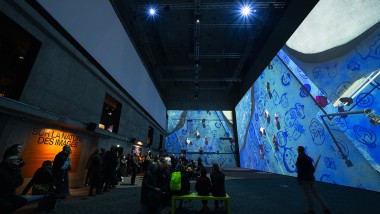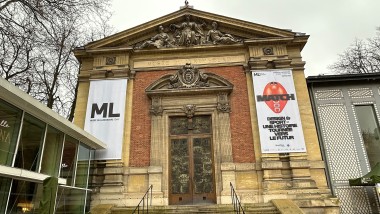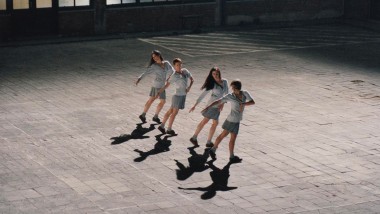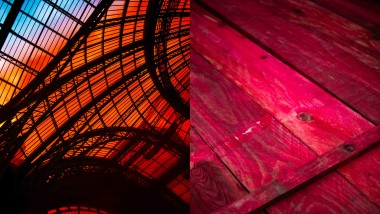
Andy Warhol (
Birth name: Andrew Warhola
Dates: 1928-1987
Formative years
Andrew Warhola was born in 1928 in Pittsburgh, Pennsylvania. He was the third son of Czechoslovakian immigrants Julia and Ondrej Warhola.
He was often ill as a child and spent a lot of time drawing or flicking through magazines with his mother.
In 1945, Andrew Warhola entered the Carnegie Institute from which he graduated in 1948. A gifted student, he stood out for the controversial nature of his work.
Beginnings in New-York – rapid recognition as an illustrator
Once graduated, he headed straight for New York. Very quickly, in spite of his timid manner, his obstinacy and the quality of his portfolio gave him an entrée into the leading magazines.
He drew especially for Glamour and adopted the name Andy Warhol. The highly original and light-hearted style of his easily recognizable illustrations very soon earned him recognition. His tremendous capacity for work won him numerous orders and he became a well-known illustrator. He regularly created shoe advertisements for I. Miller.
During the same period, he also produced several self-published albums: A is an Alphabet, Love is a Pink Cake and In the Bottom of my Garden.
Breaking into the fine art world
At the end of the 1950s, Warhol was no longer satisfied with his career as an illustrator and set his sights on becoming an artist in his own right.
The break through of John Rauschenberg and Jasper Johns marked the final victory for abstract expressionism.
Warhol’s style developed a lot during this period and he produced his first paintings using an opaque projector based on cartoons and advertisements.
In 1961, he met Ivan Karp, who ran the Castelli gallery, and invited him to his studio. He was soon followed by Henry Geldzahler, a young curator at the Metropolitan Museum, Irving Blum, owner of the Ferus Gallery in Los Angeles as well as a number of collectors.
He discovered the work of Roy Lichtenstein and abandoned cartoons in favour of consumer objects, leading to the Campbell’s Soup series. These paintings, of a quite mechanical precision producing a new still-life genre, disconcerted the art scene and marked a decisive turning point in the artist’s career.
Irving Blum presented Andy Warhol’s first personal exhibition in July 1962.
Andy Warhol – dedicated pop artist
Andy Warhol began introducing screen printing into his paintings in 1962. He produced numerous portraits of movie stars using this procedure, including Troy Donahue, Warren Betty and the whole series of Marilyn Monroe.
In November 1962, he finally obtained his first solo New York exhibition at the Stable Gallery. It was a success.
Andy Warhol was now one of the driving forces of a new style – pop – which was especially characterized by the choice of subjects represented and a particular vision of consumer society.
However, for Warhol pop was purely incidental. In 1963, he painted the series of road accidents, electric chairs, race riots, suicides and tuna fish disasters, thereby tackling a key theme in his work: death and its representation.
During this period he also produced his first commissioned portrait: Ethel Scull, Thirty Six Times. And in February 1963, to mark the Mona Lisa going on show at the Metropolitan Museum, he produced his Thirty are Better than One in which he juxtaposed 30 images of the famous sitter, screen-printed in black on a white background.
Warhol and the Factory
During the summer of 1963, Andy Warhol began to take an interest in underground cinema. He bought a 16mm camera and produced several films.
His productions are unusual for two reasons. He films at 24 images per second but projects the film at 16 images per second. He also chooses to concentrate on essential physiological functions such as sleeping (Sleep), eating (Eat) and sex (Blow Job).
During the same period, the artist rented a large loft he christened the Factory. The space’s interior was designed by Billy Name who completely covered it in silver foil. The Factory attracted an eclectic range of artists and drop-outs of all sorts. In 1964, Dorothy Podber, enfant terrible of the New York art scene and a friend of Billy Name, entered the Factory armed with a pistol and fired at four portraits of Marilyn which would become Shot Marilyn.
In the same year he began the Screen Tests, short filmed portraits lasting three minutes. And, a few weeks after Kennedy was assassinated, he began the Jackie series. He took part in the New York Universal Exhibition where he exhibited Most Wanted Men and joined the Leo Castelli gellery.
He continued at the same time to produce numerous films and created a new genre of stars: superstars. Jane Holzer, nicknamed Baby Jane, would be his first superstar. In May 1965, at the official opening of his exhibition at the Sonnabend gallery in Paris, he announced that he would abandon painting in favour of cinema. Paul Morrissey became his right-hand man in producing his films.
In 1966, Andy Warhol became a pioneer of psychedelic nightclubs by producing a multimedia spectacular called The Exploding Plastic Inevitable for which he collaborated with the Velvet Underground and Nico. Despite what he had said, he continued to paint and to produce portraits and self-portraits. For his second exhibition organized by Leo Castelli in 1966, he exhibited his Cows Wallpaper and floating, helium-filled clouds. That summer he filmed Chelsea Girls which would be hailed as a cinematographic masterpiece.
In February 1966, Valerie Solanas, the founder and sole member of Scum (Society for Cutting Up Men) entered the Factory and shot at Andy Warhol, seriously injuring him. He narrowly escaped death.
This was a turning point in the life of the artist, who was affected by it forever.
{ {Interview magazine and commissioned portraits}}
In 1969, Andy Warhol published the first issue of Interview, a monthly cinema review. At the same time, his work as a portrait artist increased providing him with a substantial income. Dealers, collectors, movie stars, industrialists, fashion designers, artists and politicians were all painted. The screen prints were by now produced from Polaroids.
He moved away from cinema and in 1972 began the series of Mao. His studio moved and was renamed the Office.
In 1976, he produced the Hammer and Sickles series and then the Skulls series and began dictating his diary, which would be published after his death, to Patt Hackett.
During this period, Andy Warhol was very involved with the in-crowd. He became a regular at Studio 54, the legendary nightclub located on 54th street in a former CBS studio.
In 1978, he returned to abstraction with the Oxydation Paintings and the Shadows series. He also produced a new series of rather macabre self-portraits, Self Portraits with Skulls. And then, in 1979, devoted himself to Reversals (previous compositions reproduced as negatives) and Retrovisions (patchworks of previous work).
In 1981, he met Basquiat. The two artists became friends and produced numerous paintings together, some of which were exhibited at the Shafrazi gallery. In 1985, MTV broadcast Andy Warhol’s Fifteen Minutes, a programme designed and hosted by Warhol.
In 1986, Alexandre Iolas commissioned him to produce work inspired by Leonardo’s The Last Supper, which would be shown at an exhibition in Milan in January 1987. These masterpieces tied in with a religious theme running throughout the artist’s work.
A little while later, Warhol was hospitalized for a gallbladder problem and died of complications following surgery at the age of 59.
Warhol’s work was protean, extending far beyond the boundaries of pop. An extraordinarily prolific and systematic artist, Warhol was at various times a painter, sculptor, film-maker, photographer, illustrator, author and publisher.
Deliberately provocative, he erected a system out of superficiality and held up a startling mirror: "People are always calling me a mirror and if a mirror looks into a mirror, what is there to see?”


Design goes the extra mile for sport! The trailer for the next exhibition at the Musée du Luxembourg
Article - 11 March 2024
‘Rosas Danst Rosas', A contemporary dance by Anne Teresa De Keersmaeker in response to Stein
Article - 24 January 2024

